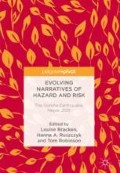Abstract
This chapter explores how the earthquake allowed other ideas to take root in Nepal and become reality. The earthquake reinvigorated central government–level interest in implementing the National Building Code. The earthquake also created the momentum for the national constitution to be promulgated after years of discussion. Based on my experience of the earthquake and the aftermath of the constitution, I propose that implementation of urban planning and earthquake-resistant construction as well as the political implications of the constitution and the ensuing economic blockade were as important as the earthquake for large parts of the country.
Access this chapter
Tax calculation will be finalised at checkout
Purchases are for personal use only
Notes
- 1.
Durham Geography Postgraduates, ‘Nepal Earthquake by Hanna Ruszczyk’, 28 April 2015. http://community.dur.ac.uk/geopad/2015/04.
- 2.
Japan had a devastating earthquake in 1923 from which the Nepal and Bihar State, India, governments were learning best practices over a decade later.
References
Bankoff, G., Cannon, T., Kruger, F., & Schipper, E. L. F. (2015). Introduction: Exploring the Links between Cultures and Disasters. In F. Krüger, G. Bankoff, T. Cannon, B. Orlowski, et al. (Eds.), Cultures and Disasters: Understanding Cultural Framings in Disaster Risk Reduction. Routledge Studies in Hazards, Disaster Risk and Climate Change (1st ed., pp. 1–16). London/New York: Routledge, Taylor & Francis Group.
Birkmann J., Buckle P., Jaeger J., & Pelling, M., et al. (2008). Extreme Events and Disasters: A Window of Opportunity for Change? Analysis of Organizational, Institutional and Political Changes, Formal and Informal Responses after Mega-disasters. Natural Hazards [Online], 55(3), 637–655. Available at: doi:https://doi.org/10.1007/s11069-008-9319-2.
Bosher, L. (Ed.). (2008). Hazards and the Built Environment: Attaining Built-In Resilience. London/New York: Taylor & Francis.
Clark, N. (2011) Inhuman Nature: Sociable Life on a Dynamic Planet (Theory, Culture & Society). Los Angeles/London: SAGE.
Edgington, D. W. (2010). Reconstructing Kobe: The Geography of Crisis and Opportunity. Vancouver: UBC Press.
Friedman, M., & Friedman R. D. (2002). Capitalism and Freedom (40th Anniversary ed.). Chicago: University of Chicago Press.
Hyndman, J. (2011). Dual Disasters: Humanitarian Aid after the 2004 Tsunami. Sterling: Kumarian Press.
IFAD. (2014). Rural Poverty in Nepal [Online]. Available at: https://www.ruralpovertyportal.org/country/home/tags/nepal. Accessed 17 Jan 2017.
Klein, N. (2008). The Rise of Disaster Capitalism. London: Penguin Books Ltd: [distributor] Penguin Books Ltd.
Pelling, M. (2012). Hazards, Risk and Urbanisation. In B. Wisner, J. C. Gaillard, & I. Kelman (Eds.), The Routledge Handbook of Hazards and Disaster Risk Reduction (pp. 145–155). London/New York: Routledge.
Rāṇā, B. J. (2013). The Great Earthquake in Nepal (1934 A.D.) (1st English ed.). Kathmandu: Ratna Pustak Bhandar.
Simpson, E. (2013). The Political Biography of an Earthquake: Aftermath and Amnesia in Gujurat, India. London: Hurst.
Tanaka, M. (2009). From Confrontation to Collaboration: A Decade in the Work of the Squatters’ Movement in Nepal. Environment and Urbanization [Online], 21(1), 143–159. Available at: doi:https://doi.org/10.1177/0956247809103011.
Wisner, B., Gaillard, J. C., & Kelman, I. (Eds.). (2012). The Routledge Handbook of Hazards and Disaster Risk Reduction. London/New York: Routledge.
World Bank. (2016, January). Nepal Development Update, Development Amidst Disturbances. Report number 103351.
Yiftachel, O. (2009). Critical Theory and ‘Gray Space’: Mobilization of the Colonized. City [Online], 13(2–3), 246–263. Available at: doi:https://doi.org/10.1080/13604810902982227.
Author information
Authors and Affiliations
Editor information
Editors and Affiliations
Rights and permissions
Copyright information
© 2018 The Author(s)
About this chapter
Cite this chapter
Ruszczyk, H.A. (2018). The Earthquake and Ideas Lying Around. In: Bracken, L., A. Ruszczyk, H., Robinson, T. (eds) Evolving Narratives of Hazard and Risk. Palgrave Macmillan, Cham. https://doi.org/10.1007/978-3-319-65211-5_8
Download citation
DOI: https://doi.org/10.1007/978-3-319-65211-5_8
Published:
Publisher Name: Palgrave Macmillan, Cham
Print ISBN: 978-3-319-65210-8
Online ISBN: 978-3-319-65211-5
eBook Packages: Social SciencesSocial Sciences (R0)

